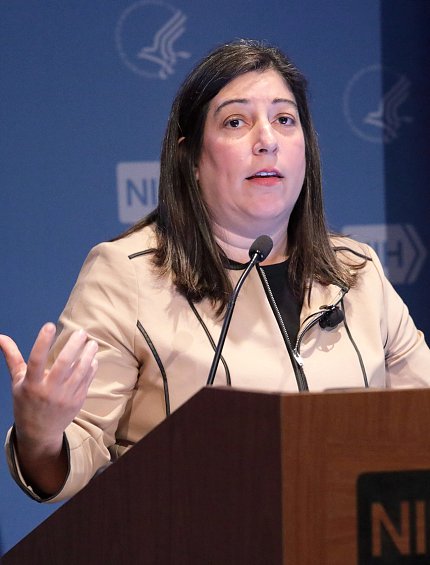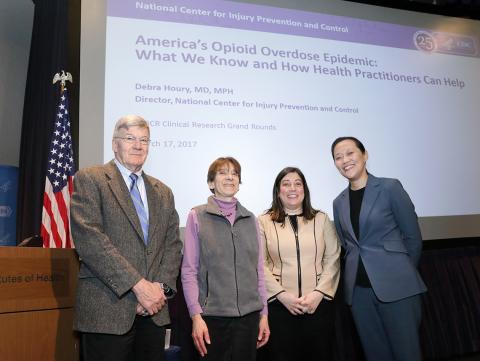Preventing Deadly Overdoses
Prescribers, Rethink Those Opioid Scripts

Photo: Ernie Branson
A dad clutches his daughter’s senior photo. She’ll never make it to graduation. After suffering a sports-related injury, the teen was prescribed an opioid for pain relief. She became addicted and joined a growing U.S. epidemic: People who died from an overdose of prescription opioids.
Images of grief-stricken families hauntDr. Debra Houry, director of the National Center for Injury Prevention and Control at the Centers for Disease Control and Prevention. A practicing emergency room doctor for more than 15 years, she gave a lecture, “America’s Opioid Overdose Epidemic: What We Know and How Health Practitioners Can Help,” at NIDCR Clinical Research Grand Rounds recently.
“For me, the opioid epidemic has been personal,” Houry explained. “I still see my patients’ faces and remember their stories. I’ve seen [the epidemic] evolve over the past 15 years. I’ve seen patients come in with really intractable pain—you want to take care of their pain. I’ve seen patients struggling with addiction and I’ve helped them navigate the system. I’ve also seen patients after they’ve overdosed and I’ve reversed them with naloxone. I’ve also not been successful at times and had to tell family members they’ve lost a loved one.”
Dawn of an Epidemic
The first signs of trouble, according to CDC data, began around the mid-1990s, when opioids/heroin started dramatically rising as the cause for unintentional drug poisoning mortality. Drug overdoses became the second leading cause of death from injury in the late 1990s. [Death after motor vehicle injury was number one.]
By the early 2000s, medical examiners and health departments in states such as Maine and North Carolina began to report growing prescription drug abuse and an increase in drug deaths due to prescription narcotics. In a decade and a half, the epidemic spread across the U.S.
What was driving these increases? CDC wanted to know.
After launching an investigation in 2004 with data from the Drug Enforcement Administration, the Substance Abuse and Mental Health Services Administration and other agencies, CDC published findings in 2006 in Pharmacoepidemiology and Drug Safety.
“We started seeing that it was linked to opioid sales,” Houry said. “There was a really close association between opioid analgesic deaths and opioid analgesic prescribing.”
More Prescriptions, More Deadly
Data show that the amount of opioid prescriptions dispensed has quadrupled since 1999, Houry said. The pain Americans report, however, has not changed.
“About 250 million [opioid] prescriptions are written each year in the U.S.—enough for every single adult in the U.S. to have his or her own bottle of pills,” she noted. Americans account for more than 80 percent of the world’s opioid consumption.
Prescription opioids can be blamed for 165,000 deaths since 1999, Houry continued. Factor in illicit opioids such as heroin and fentanyl, and 78 people die each day in the U.S. from an opioid.
In addition, data show that misusing a pain prescription puts people at risk of using heroin. Three out of 4 people who used heroin in the past year misused opioids first.
“A lot of the changes are thought to be due to the widespread availability of illicit drugs,” Houry said. Another reason for the increase in overdose deaths is that today’s drugs are so deadly, she pointed out. Fentanyl is a hundred times more potent than a regular prescription pain reliever such as Vicodin. As a result, emergency medical service providers now need higher doses of anti-opioids to reverse overdoses.
“One of the ways we can change this [deadly cycle] is by focusing on not having people get addicted to prescription opioids in the first place,” Houry said. “Then they wouldn’t be going on to use heroin and fentanyl.”
Prescribers Play a Part
The National Institute of Dental and Craniofacial Research, a founding institute of NIH’s Pain Consortium, invited Houry’s opioid conversation.
“Opioids are an important topic for us because dentists are one of the major prescribers of immediate-release opioids,” said NIDCR acting deputy director Dr. John Kusiak, who introduced the lecture. “Oral-facial pain is one of the important common pain conditions that afflicts people in the United States.”

Photo: Ernie Branson
Overall, dentists prescribed more than 6 percent of all opioids in 2012, Houry reported. For patients ages 10 to 19, 30 percent of prescription opioids come from dentists. Youngsters often are initiated to opioid use following tooth extractions or athletic injuries.
Practitioners need to think about alternatives to opioids and perhaps to prescribing drugs in general, Houry said. Non-steroidal medications to manage pain and non-drug options such as exercise therapy should be considered more often.
“We need to manage pain, but we need to manage pain appropriately and safely,” she emphasized.
Awareness Important, Prevention Paramount
Last year, CDC released its Guideline for Prescribing Opioids for Chronic Pain. The document targets primary care providers for adults ages 18 and older in outpatient settings. People who have active cancer diagnoses or who need palliative or end-of-life care were specifically excluded.
In general, CDC recommends that opioids not be routine therapy for chronic pain, that they be prescribed at the lowest effective dosage and that all patients be monitored closely.
“As practitioners, we have to realize that everything we do has a long-term impact—for better or worse,” Houry said.
She noted that CDC prevention efforts have three pillars: improve data quality, timeliness and track trends; strengthen state initiatives by scaling up effective public health interventions; and equip health care providers with information and tools for evidence-based decision-making.
CDC also urges more practitioners to use state PDMPs, or prescription drug monitoring programs. Such tools help prescribers keep track of critical clinical data that could warn of possible drug interactions or signal a patient’s potential risk for overdose.
Still, ER physician Houry concluded, tools and knowledge of trends cannot replace actual conversations between individual patients and their health care providers about prescription use—and abuse.
“At CDC, I was able to take a step back and look at the big picture view, look at data and what we could do with state health departments,” she said, “but I think it’s important to keep that grasp of reality on the ground and remember those faces and those stories, because that’s really what should drive what we do—the patients and the public.”
